人教版(2019)必修第三册Unit 2 Morals and Virtues Discovering Useful Structures 课件(共35张PPT)
文档属性
| 名称 | 人教版(2019)必修第三册Unit 2 Morals and Virtues Discovering Useful Structures 课件(共35张PPT) | 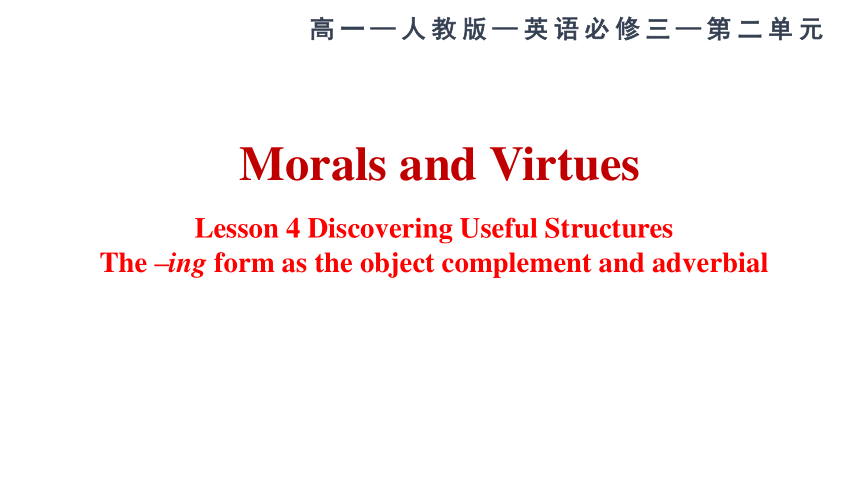 | |
| 格式 | pptx | ||
| 文件大小 | 2.7MB | ||
| 资源类型 | 教案 | ||
| 版本资源 | 人教版(2019) | ||
| 科目 | 英语 | ||
| 更新时间 | 2024-05-22 16:37:24 | ||
图片预览

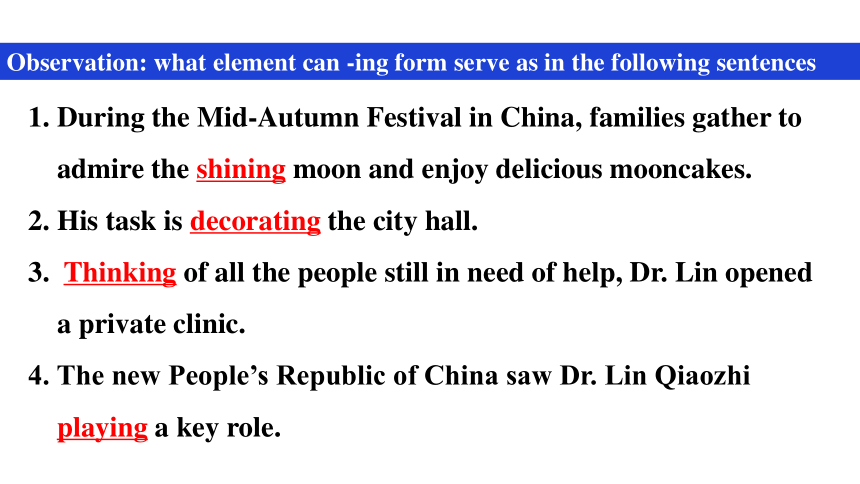
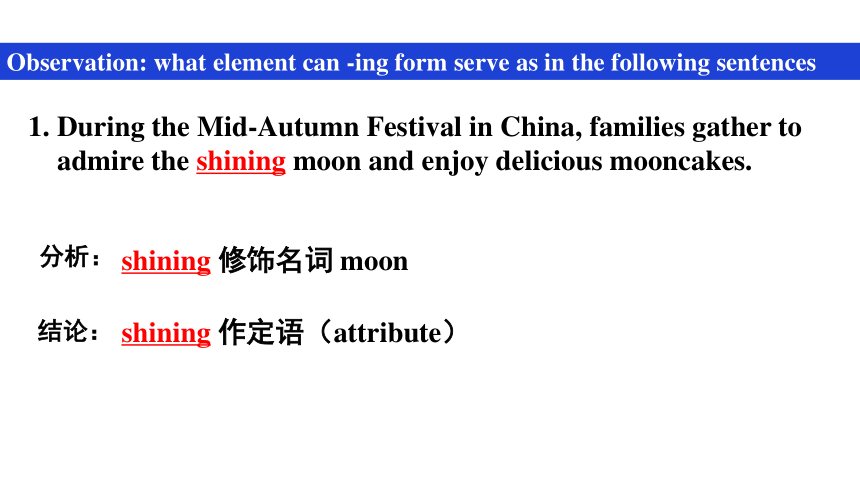
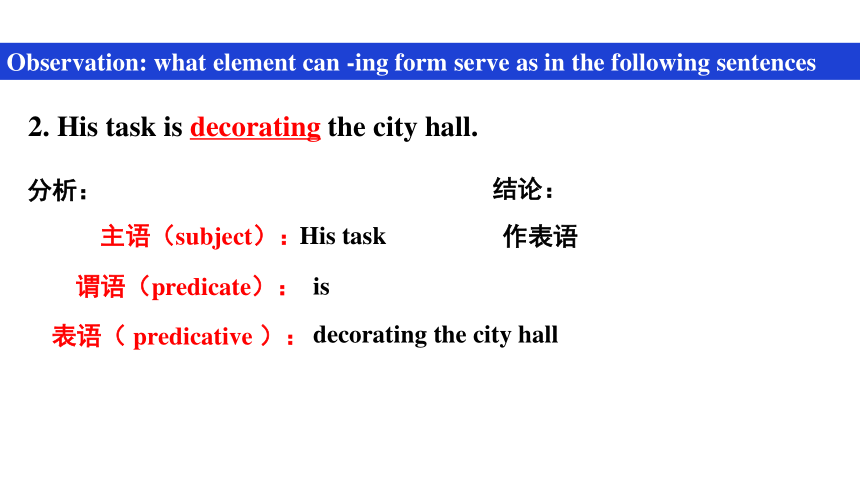
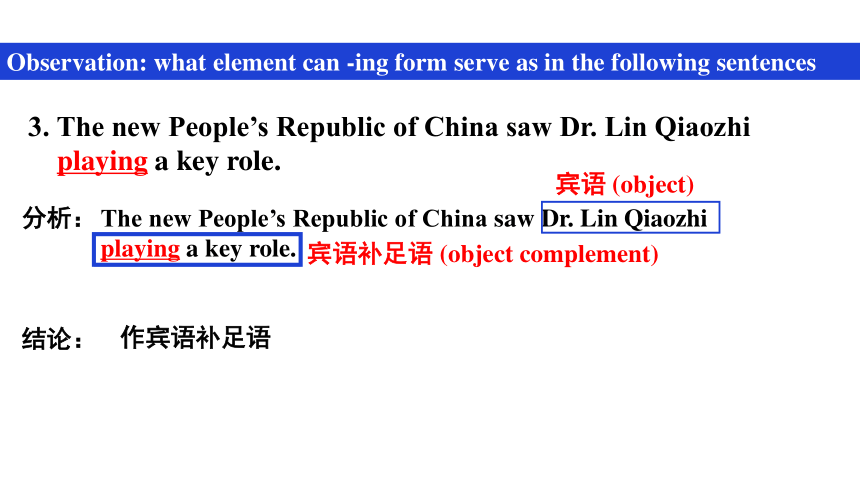
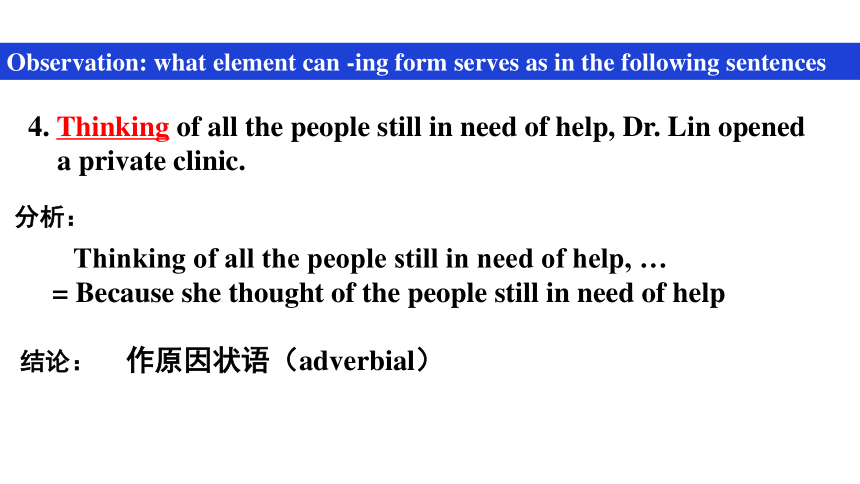
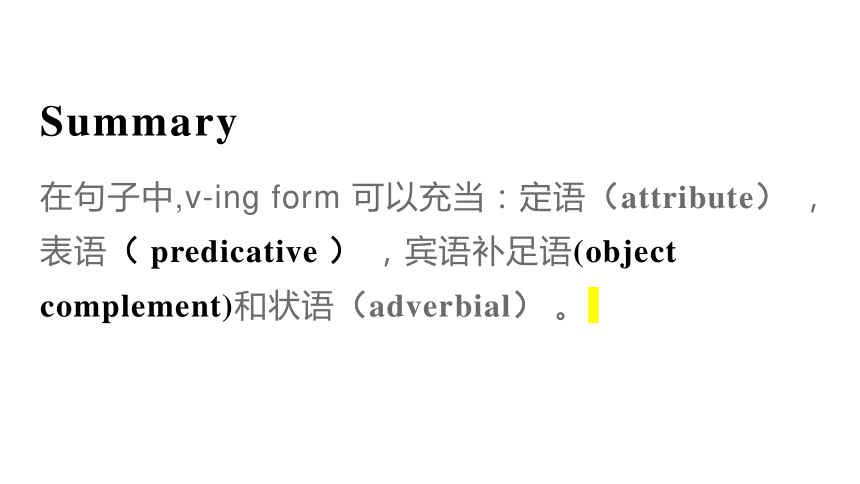
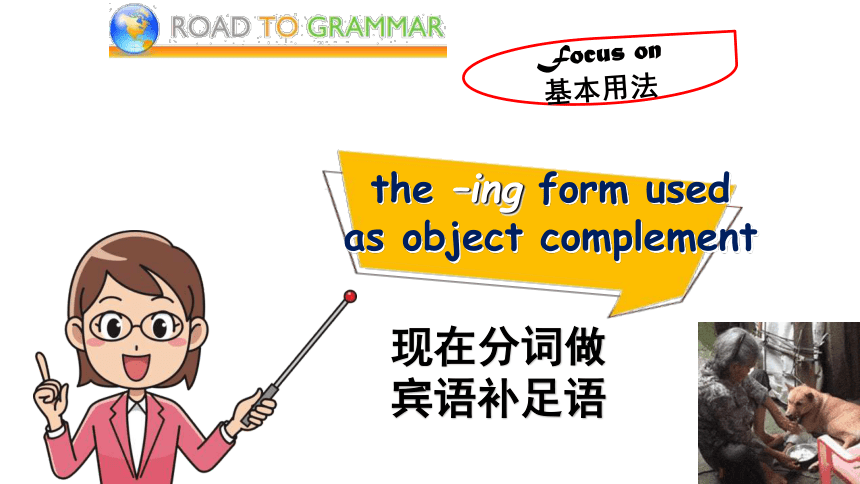
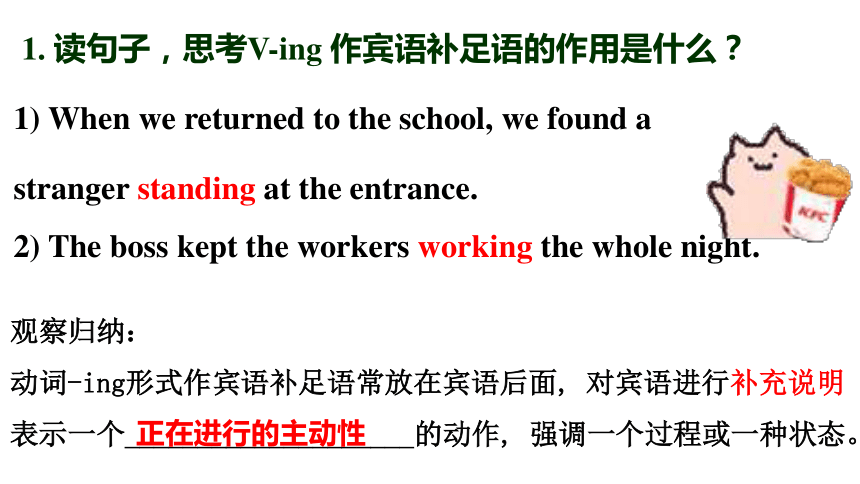
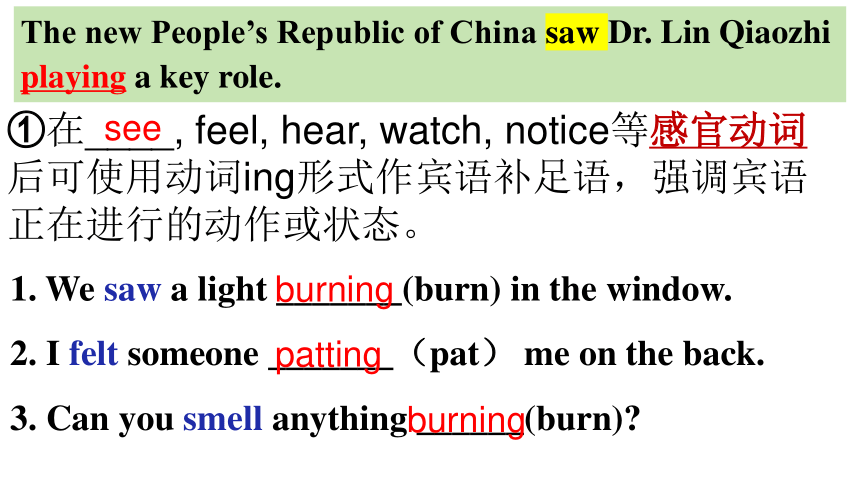
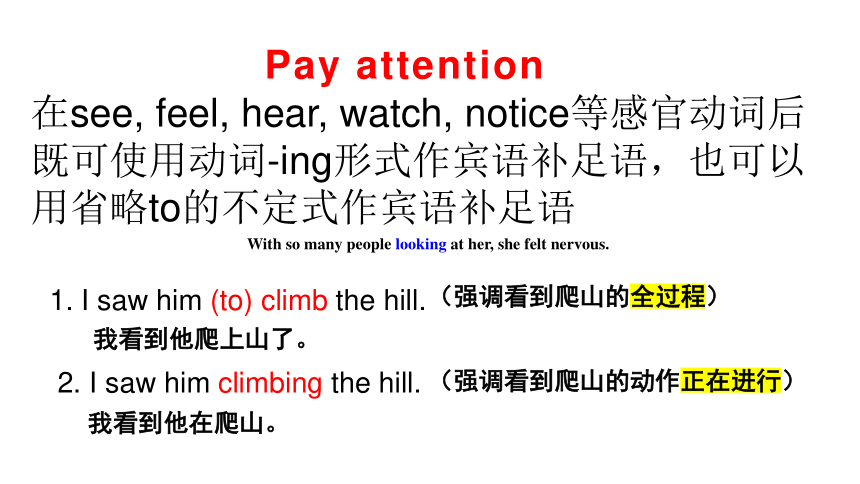
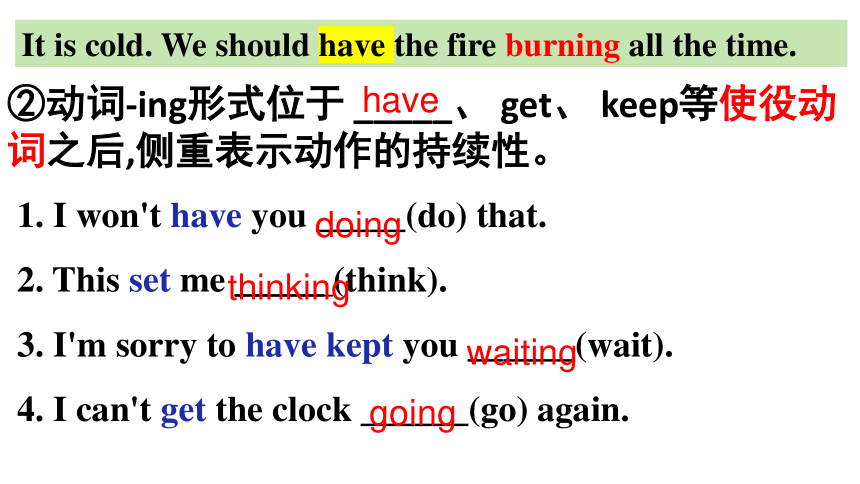
文档简介
(共35张PPT)
Morals and Virtues
Lesson 4 Discovering Useful Structures
The –ing form as the object complement and adverbial
高一—人教版—英语必修三—第二单元
1. During the Mid-Autumn Festival in China, families gather to
admire the shining moon and enjoy delicious mooncakes.
2. His task is decorating the city hall.
3. Thinking of all the people still in need of help, Dr. Lin opened
a private clinic.
4. The new People’s Republic of China saw Dr. Lin Qiaozhi
playing a key role.
Observation: what element can -ing form serve as in the following sentences
1. During the Mid-Autumn Festival in China, families gather to
admire the shining moon and enjoy delicious mooncakes.
shining 修饰名词 moon
分析:
结论:
shining 作定语(attribute)
Observation: what element can -ing form serve as in the following sentences
2. His task is decorating the city hall.
主语(subject):
谓语(predicate):
表语( predicative ):
His task
is
decorating the city hall
作表语
分析:
结论:
Observation: what element can -ing form serve as in the following sentences
3. The new People’s Republic of China saw Dr. Lin Qiaozhi
playing a key role.
The new People’s Republic of China saw Dr. Lin Qiaozhi playing a key role.
宾语 (object)
宾语补足语 (object complement)
作宾语补足语
分析:
结论:
Observation: what element can -ing form serve as in the following sentences
4. Thinking of all the people still in need of help, Dr. Lin opened
a private clinic.
Thinking of all the people still in need of help, …
= Because she thought of the people still in need of help
作原因状语(adverbial)
分析:
结论:
Observation: what element can -ing form serves as in the following sentences
Summary
在句子中,v-ing form 可以充当:定语(attribute) ,表语( predicative ) ,宾语补足语(object complement)和状语(adverbial) 。
Focus on
基本用法
the –ing form used
as object complement
现在分词做
宾语补足语
观察归纳:
动词-ing形式作宾语补足语常放在宾语后面, 对宾语进行补充说明表示一个____________________的动作, 强调一个过程或一种状态。
正在进行的主动性
1. 读句子,思考V-ing 作宾语补足语的作用是什么?
1) When we returned to the school, we found a
stranger standing at the entrance.
2) The boss kept the workers working the whole night.
The new People’s Republic of China saw Dr. Lin Qiaozhi playing a key role.
①在____, feel, hear, watch, notice等感官动词后可使用动词ing形式作宾语补足语,强调宾语正在进行的动作或状态。
1. We saw a light _______(burn) in the window.
2. I felt someone _______(pat) me on the back.
3. Can you smell anything ______(burn)
see
burning
patting
burning
Pay attention
在see, feel, hear, watch, notice等感官动词后既可使用动词-ing形式作宾语补足语,也可以用省略to的不定式作宾语补足语
1. I saw him (to) climb the hill.
2. I saw him climbing the hill.
我看到他爬上山了。
(强调看到爬山的全过程)
我看到他在爬山。
(强调看到爬山的动作正在进行)
With so many people looking at her, she felt nervous.
②动词-ing形式位于 _____、 get、 keep等使役动词之后,侧重表示动作的持续性。
1. I won't have you _____(do) that.
2. This set me _____ (think).
3. I'm sorry to have kept you ______(wait).
4. I can't get the clock ______(go) again.
It is cold. We should have the fire burning all the time.
have
doing
thinking
waiting
going
【应用实践】
单句语法填空。
①If a cook is found (smoke) in the kitchen, he will be fired.
②I won’t have you (run) about in the room.
③We saw the teacher (do) the experiment.
④At the airport, a man dressed in a black suit was caught (spit) on the clean floor.
smoking
running
doing
spitting
Focus on
基本用法
the –ing form used
as adverbial
现在分词做状语
现在分词作时间状语时,相当于时间状语从句。
可在现在分词前加连词“when, while, until”等,使其时间
意义更明确。
Hearing the news, he couldn’t help laughing. (作时间状语)
= When he heard the news, he couldn’t help laughing.
听到那个消息,他不禁大笑起来。
v-ing形式作时间状语
e.g. Seeing the police, he made a run for the exit.
一看到警察,他就朝出口奔去。
分析:see的动作是由其逻辑主语“he”发出,与句子的主语he一致,且构成主动关系,所以用动词-ing形式。
将下面的时间状语从句改写成简单句。
When he walked out of the room, he saw a dog.
Walking out of the room, he saw a dog.
1. 作时间状语
现在分词作原因状语时,可转换为由since, because或as引导的原因状语从句,这类状语多放在句子的前半部分。
Being poor, he couldn’t afford a house. (作原因状语)
=Because he was poor, he couldn’t afford a house.
因为穷,他买不起房子。
v-ing形式作原因状语
e.g. Being ill, he didn’t go to school yesterday.
因为生病了,他昨天没有上学。
分析: He is ill是He didn’t go to school的原因。be的逻辑主语和句子主语是一致, 主动关系,用动词-ing形式
Not knowing the way, he got lost.
翻译句子:由于不认路,他迷路了。
As he ____________________, he got lost.
didn’t know the way
动词-ing形式的否定式是在其前面加not。
2. 作原因状语
现在分词作条件状语时,可转换为if, once或unless等引导的条件状语从句。
Working hard, you’ll surely succeed. (作条件状语)
=If you work hard, you’ll surely succeed.
如果你努力工作,就一定会成功。
v-ing形式作条件状语
e.g. Turning to the left, you will see a school.
向左转你就会看到一所学校。
If we ___________ , we will succeed.
翻译句子:努力学习, 我们就会成功。
Studying hard , we will succeed.
study hard
3. 作条件状语
现在分词作让步状语时,相当于一个以though/although引导的让步状语从句。
Knowing the whole thing, they still made me pay for the damage.
(作让步状语)
=Though they knew the whole thing, they still made me pay for the damage.
尽管他们知道整件事情的经过,却还让我赔偿损失。
v-ing形式作让步状语
e.g. Granting this to be true, we cannot explain it.
虽然我们承认这是事实,却无法予以说明。
Knowing it is difficult, I don’t give up.
翻译句子:
虽然知道它很难,我也不放弃。
Although I _________________, I don’t give up.
know it is difficult
4. 作让步状语
现在分词作方式,结果或伴随状语时,通常不能转换为状语从句,但可用并列分句代替。
The boy sat in front of the farm house, cutting the branch. (作伴随状语)
=The boy sat in front of the farm house, and he cut the branch.
那个男孩坐在农舍前砍树枝。
The child slipped and fell, hitting his head against the door. (作结果状语)
=The child slipped and fell, and he hit his head against the door.
那个男孩滑了一跤,头撞到了门上。
v-ing形式作方式/结果/伴随状语
e.g. You gave me such a fright creeping up on me like that!
你那样不声不响地从后面过来,吓我一跳!
用动词-ing形式作状语的结构翻译下列句子。
请你用另一种方式回答问题。
Please answer the question using another way.
作方式状语
【探究总结】
(1)动词-ing形式在句中作状语时,用来修饰谓语动词或整个句子,常表示动作发生的时间、原因、条件、结果、方式或表示伴随、让步等,并可以转换成相应的状语从句或并列句。
(2)动词-ing形式作状语时,其逻辑主语一般是句子的主语。
(3)动词-ing形式的否定式是在其前加not。
(4)动词-ing形式前可加上适当的连词,如when、 while、 whenever、 if、 though、 unless等强调前后动作的同时性或使动词-ing形式表达的含义更加明确。
【应用实践】
(1)单句语法填空。
① (see) the pictures, she remembered her childhood.
② (ill), he couldn’t go to school.
③ (work) hard, you’ll make great progress in English.
④His parents died, (leave) him an orphan.
⑤He came (run) back to tell me the news.
⑥She walked along the street, (sing) softly to herself.
⑦ (work) very hard, he didn’t feel a bit tired.
Seeing
Being ill
Working
leaving
running
singing
Working
1.动词分为谓语动词和非谓语动词,当一个简单句或从句中已经出现了一个谓语动词或系动词,那么第二个动词要变成非谓语形式(V-ed/V-ing/ to do)
2.动词的非谓语可做除谓语之外的任何成分,如定语,宾语,表语,宾补,状语,主语等。
3. 非谓语中分词形式的选择要先找其逻辑主语,在判断其逻辑主语与非谓语间的关系,现在分词主动或进行,过去分词被动或完成。
非谓语动词
with的复合结构
With so many people looking at her, she felt nervous.
当--ing表示的动作于主句的动作同时或者在主语的动作之后发生,使用一般时:doing
当--ing表示的动作发生在谓语动词之前时,应使用完成式: having done.
Reading the book, he nodded from time to time.
看书时,他不时地点着头。
Having finished all his homework, he went out to play.
完成所有作业之后,他就出去玩了。
Being surrounded, the enemy was forced to give in.
由于被包围着,敌人被迫投降。
Having been told many times, he still didn’t learn these rules by heart.
尽管被告知了很多次,他还是没记住这些规定。
(2)动词-ing形式的被动式表示动作与逻辑主语是 关系。根据动词-ing 形式的动作发生的时间,被动式有一般被动式 (表示动作 )和完成被动式 (表示动作 )。
被动
being done
正在被进行
having been done
已经被完成
3. 动词-ing形式的特殊结构
【观察思考】
The rain having stopped, we went on marching.
雨过之后,我们继续前进。
Generally speaking, boys like playing with balls while girls like playing with dolls.
一般来说,男孩喜欢玩球,而女孩喜欢玩娃娃。
【探究总结】
(1)独立主格结构。
动词-ing形式作状语,有时可以有自己独立的 ,这种结构称为
,通常用来表示伴随的动作或情况,也可以表示时间、原因或条件等。
(2)有些动词-ing形式作状语,在句中没有逻辑上的主语而独立存在,用来修饰主句,表明说话者的态度、观点等,被称为 。常见的有:generally/strictly/frankly speaking、 judging from、 considering、 supposing、 providing等。
逻辑主语
独立主格结构
评注性状语/悬垂分词
Complete the sentences with the correct forms os the verbs in the box.
feel want face smile return worry hear knock
Hearing
worrying
wanting
knocking
Facing
Returning
smiling
Feeling
1. All customers _________ (travel) on TransLink services must be in _________ (possess) of a valid ticket before boarding.
2. In fact, anyone _________ (wish) to try race walking should probably first consult a coach or ___________ (experience) racer _________ (learn) proper technique.
3. One of his latest projects has been to make plants grow in experiments _________(use) some common vegetables.
travelling
possession
experienced
wishing
to learn
高考链接
using
4. Nervously _________ (face) challenges, I know I will whisper to myself the two simple words “Be yourself”.
5. _______________ (work) for two days, Steve managed to finish his report on schedule.
6. All the football players on the playground cheered loudly, _____ (say) that I had a talent _________ football.
7. _________ (turn) around, we saw an old woman _________; (walk) towards the river.
高考链接
facing
Having worked
saying
for
Turning
walking
Morals and Virtues
Lesson 4 Discovering Useful Structures
The –ing form as the object complement and adverbial
高一—人教版—英语必修三—第二单元
1. During the Mid-Autumn Festival in China, families gather to
admire the shining moon and enjoy delicious mooncakes.
2. His task is decorating the city hall.
3. Thinking of all the people still in need of help, Dr. Lin opened
a private clinic.
4. The new People’s Republic of China saw Dr. Lin Qiaozhi
playing a key role.
Observation: what element can -ing form serve as in the following sentences
1. During the Mid-Autumn Festival in China, families gather to
admire the shining moon and enjoy delicious mooncakes.
shining 修饰名词 moon
分析:
结论:
shining 作定语(attribute)
Observation: what element can -ing form serve as in the following sentences
2. His task is decorating the city hall.
主语(subject):
谓语(predicate):
表语( predicative ):
His task
is
decorating the city hall
作表语
分析:
结论:
Observation: what element can -ing form serve as in the following sentences
3. The new People’s Republic of China saw Dr. Lin Qiaozhi
playing a key role.
The new People’s Republic of China saw Dr. Lin Qiaozhi playing a key role.
宾语 (object)
宾语补足语 (object complement)
作宾语补足语
分析:
结论:
Observation: what element can -ing form serve as in the following sentences
4. Thinking of all the people still in need of help, Dr. Lin opened
a private clinic.
Thinking of all the people still in need of help, …
= Because she thought of the people still in need of help
作原因状语(adverbial)
分析:
结论:
Observation: what element can -ing form serves as in the following sentences
Summary
在句子中,v-ing form 可以充当:定语(attribute) ,表语( predicative ) ,宾语补足语(object complement)和状语(adverbial) 。
Focus on
基本用法
the –ing form used
as object complement
现在分词做
宾语补足语
观察归纳:
动词-ing形式作宾语补足语常放在宾语后面, 对宾语进行补充说明表示一个____________________的动作, 强调一个过程或一种状态。
正在进行的主动性
1. 读句子,思考V-ing 作宾语补足语的作用是什么?
1) When we returned to the school, we found a
stranger standing at the entrance.
2) The boss kept the workers working the whole night.
The new People’s Republic of China saw Dr. Lin Qiaozhi playing a key role.
①在____, feel, hear, watch, notice等感官动词后可使用动词ing形式作宾语补足语,强调宾语正在进行的动作或状态。
1. We saw a light _______(burn) in the window.
2. I felt someone _______(pat) me on the back.
3. Can you smell anything ______(burn)
see
burning
patting
burning
Pay attention
在see, feel, hear, watch, notice等感官动词后既可使用动词-ing形式作宾语补足语,也可以用省略to的不定式作宾语补足语
1. I saw him (to) climb the hill.
2. I saw him climbing the hill.
我看到他爬上山了。
(强调看到爬山的全过程)
我看到他在爬山。
(强调看到爬山的动作正在进行)
With so many people looking at her, she felt nervous.
②动词-ing形式位于 _____、 get、 keep等使役动词之后,侧重表示动作的持续性。
1. I won't have you _____(do) that.
2. This set me _____ (think).
3. I'm sorry to have kept you ______(wait).
4. I can't get the clock ______(go) again.
It is cold. We should have the fire burning all the time.
have
doing
thinking
waiting
going
【应用实践】
单句语法填空。
①If a cook is found (smoke) in the kitchen, he will be fired.
②I won’t have you (run) about in the room.
③We saw the teacher (do) the experiment.
④At the airport, a man dressed in a black suit was caught (spit) on the clean floor.
smoking
running
doing
spitting
Focus on
基本用法
the –ing form used
as adverbial
现在分词做状语
现在分词作时间状语时,相当于时间状语从句。
可在现在分词前加连词“when, while, until”等,使其时间
意义更明确。
Hearing the news, he couldn’t help laughing. (作时间状语)
= When he heard the news, he couldn’t help laughing.
听到那个消息,他不禁大笑起来。
v-ing形式作时间状语
e.g. Seeing the police, he made a run for the exit.
一看到警察,他就朝出口奔去。
分析:see的动作是由其逻辑主语“he”发出,与句子的主语he一致,且构成主动关系,所以用动词-ing形式。
将下面的时间状语从句改写成简单句。
When he walked out of the room, he saw a dog.
Walking out of the room, he saw a dog.
1. 作时间状语
现在分词作原因状语时,可转换为由since, because或as引导的原因状语从句,这类状语多放在句子的前半部分。
Being poor, he couldn’t afford a house. (作原因状语)
=Because he was poor, he couldn’t afford a house.
因为穷,他买不起房子。
v-ing形式作原因状语
e.g. Being ill, he didn’t go to school yesterday.
因为生病了,他昨天没有上学。
分析: He is ill是He didn’t go to school的原因。be的逻辑主语和句子主语是一致, 主动关系,用动词-ing形式
Not knowing the way, he got lost.
翻译句子:由于不认路,他迷路了。
As he ____________________, he got lost.
didn’t know the way
动词-ing形式的否定式是在其前面加not。
2. 作原因状语
现在分词作条件状语时,可转换为if, once或unless等引导的条件状语从句。
Working hard, you’ll surely succeed. (作条件状语)
=If you work hard, you’ll surely succeed.
如果你努力工作,就一定会成功。
v-ing形式作条件状语
e.g. Turning to the left, you will see a school.
向左转你就会看到一所学校。
If we ___________ , we will succeed.
翻译句子:努力学习, 我们就会成功。
Studying hard , we will succeed.
study hard
3. 作条件状语
现在分词作让步状语时,相当于一个以though/although引导的让步状语从句。
Knowing the whole thing, they still made me pay for the damage.
(作让步状语)
=Though they knew the whole thing, they still made me pay for the damage.
尽管他们知道整件事情的经过,却还让我赔偿损失。
v-ing形式作让步状语
e.g. Granting this to be true, we cannot explain it.
虽然我们承认这是事实,却无法予以说明。
Knowing it is difficult, I don’t give up.
翻译句子:
虽然知道它很难,我也不放弃。
Although I _________________, I don’t give up.
know it is difficult
4. 作让步状语
现在分词作方式,结果或伴随状语时,通常不能转换为状语从句,但可用并列分句代替。
The boy sat in front of the farm house, cutting the branch. (作伴随状语)
=The boy sat in front of the farm house, and he cut the branch.
那个男孩坐在农舍前砍树枝。
The child slipped and fell, hitting his head against the door. (作结果状语)
=The child slipped and fell, and he hit his head against the door.
那个男孩滑了一跤,头撞到了门上。
v-ing形式作方式/结果/伴随状语
e.g. You gave me such a fright creeping up on me like that!
你那样不声不响地从后面过来,吓我一跳!
用动词-ing形式作状语的结构翻译下列句子。
请你用另一种方式回答问题。
Please answer the question using another way.
作方式状语
【探究总结】
(1)动词-ing形式在句中作状语时,用来修饰谓语动词或整个句子,常表示动作发生的时间、原因、条件、结果、方式或表示伴随、让步等,并可以转换成相应的状语从句或并列句。
(2)动词-ing形式作状语时,其逻辑主语一般是句子的主语。
(3)动词-ing形式的否定式是在其前加not。
(4)动词-ing形式前可加上适当的连词,如when、 while、 whenever、 if、 though、 unless等强调前后动作的同时性或使动词-ing形式表达的含义更加明确。
【应用实践】
(1)单句语法填空。
① (see) the pictures, she remembered her childhood.
② (ill), he couldn’t go to school.
③ (work) hard, you’ll make great progress in English.
④His parents died, (leave) him an orphan.
⑤He came (run) back to tell me the news.
⑥She walked along the street, (sing) softly to herself.
⑦ (work) very hard, he didn’t feel a bit tired.
Seeing
Being ill
Working
leaving
running
singing
Working
1.动词分为谓语动词和非谓语动词,当一个简单句或从句中已经出现了一个谓语动词或系动词,那么第二个动词要变成非谓语形式(V-ed/V-ing/ to do)
2.动词的非谓语可做除谓语之外的任何成分,如定语,宾语,表语,宾补,状语,主语等。
3. 非谓语中分词形式的选择要先找其逻辑主语,在判断其逻辑主语与非谓语间的关系,现在分词主动或进行,过去分词被动或完成。
非谓语动词
with的复合结构
With so many people looking at her, she felt nervous.
当--ing表示的动作于主句的动作同时或者在主语的动作之后发生,使用一般时:doing
当--ing表示的动作发生在谓语动词之前时,应使用完成式: having done.
Reading the book, he nodded from time to time.
看书时,他不时地点着头。
Having finished all his homework, he went out to play.
完成所有作业之后,他就出去玩了。
Being surrounded, the enemy was forced to give in.
由于被包围着,敌人被迫投降。
Having been told many times, he still didn’t learn these rules by heart.
尽管被告知了很多次,他还是没记住这些规定。
(2)动词-ing形式的被动式表示动作与逻辑主语是 关系。根据动词-ing 形式的动作发生的时间,被动式有一般被动式 (表示动作 )和完成被动式 (表示动作 )。
被动
being done
正在被进行
having been done
已经被完成
3. 动词-ing形式的特殊结构
【观察思考】
The rain having stopped, we went on marching.
雨过之后,我们继续前进。
Generally speaking, boys like playing with balls while girls like playing with dolls.
一般来说,男孩喜欢玩球,而女孩喜欢玩娃娃。
【探究总结】
(1)独立主格结构。
动词-ing形式作状语,有时可以有自己独立的 ,这种结构称为
,通常用来表示伴随的动作或情况,也可以表示时间、原因或条件等。
(2)有些动词-ing形式作状语,在句中没有逻辑上的主语而独立存在,用来修饰主句,表明说话者的态度、观点等,被称为 。常见的有:generally/strictly/frankly speaking、 judging from、 considering、 supposing、 providing等。
逻辑主语
独立主格结构
评注性状语/悬垂分词
Complete the sentences with the correct forms os the verbs in the box.
feel want face smile return worry hear knock
Hearing
worrying
wanting
knocking
Facing
Returning
smiling
Feeling
1. All customers _________ (travel) on TransLink services must be in _________ (possess) of a valid ticket before boarding.
2. In fact, anyone _________ (wish) to try race walking should probably first consult a coach or ___________ (experience) racer _________ (learn) proper technique.
3. One of his latest projects has been to make plants grow in experiments _________(use) some common vegetables.
travelling
possession
experienced
wishing
to learn
高考链接
using
4. Nervously _________ (face) challenges, I know I will whisper to myself the two simple words “Be yourself”.
5. _______________ (work) for two days, Steve managed to finish his report on schedule.
6. All the football players on the playground cheered loudly, _____ (say) that I had a talent _________ football.
7. _________ (turn) around, we saw an old woman _________; (walk) towards the river.
高考链接
facing
Having worked
saying
for
Turning
walking
